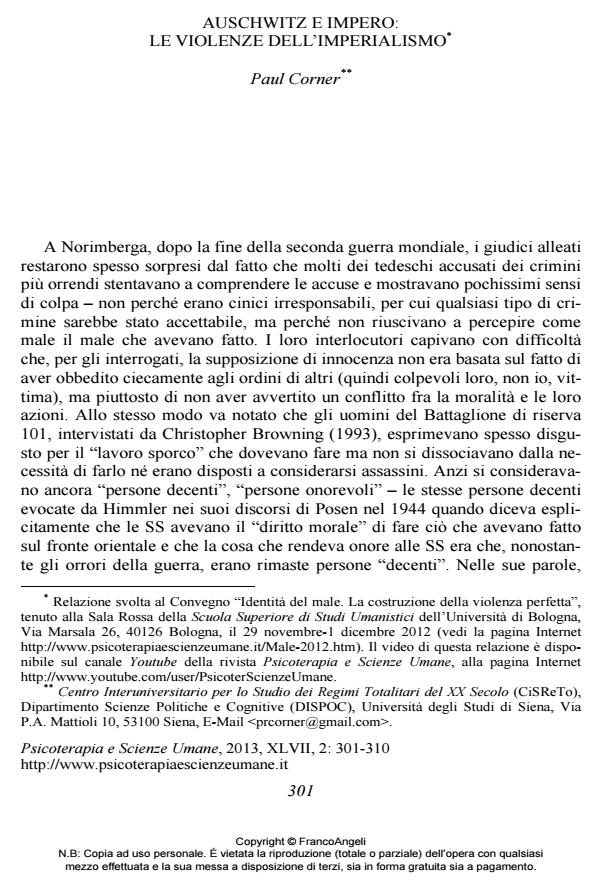Auschwitz and empire: The violence of imperialism
Journal title PSICOTERAPIA E SCIENZE UMANE
Author/s Paul Corner
Publishing Year 2013 Issue 2013/2 Language Italian
Pages 10 P. 301-310 File size 253 KB
DOI 10.3280/PU2013-002011
DOI is like a bar code for intellectual property: to have more infomation
click here
Below, you can see the article first page
If you want to buy this article in PDF format, you can do it, following the instructions to buy download credits

FrancoAngeli is member of Publishers International Linking Association, Inc (PILA), a not-for-profit association which run the CrossRef service enabling links to and from online scholarly content.
The article examines the links suggested by certain historians between the German experience of colonial rule in Africa before the First World War, with the massacre of the Herero, and the genocide carried out by the Nazis in Central and Eastern Europe between 1939 and 1945. While it concedes many of the points made by these historians in relation to the importance of the German colonial experience in forming ideas of racial hierarchy, it questions the assertion of a too-direct link with the Shoah and insists on the essential role played by First World War itself in catalyzing German attitudes towards expansion within Europe and in generating a culture of violence. It concludes by arguing that Nazi attitudes towards the peoples of Eastern Europe were conditioned essentially by defensive thinking, based on fears of encirclement, thus providing a justification for mass murder which, as a consequence, was not perceived as such by many ordinary Germans.
Keywords: Genocide, empire, Nazism, First World War, Generalplan Ost
- Arendt H. (1963). Eichmann in Jerusalem: A Report on the Banality of Evil. New York: Viking Press (trad. it.: La banalità del male. Eichmann a Gerusalemme. Milano: Feltrinelli, 1964).
- Bauman Z. (1989). Modernity and the Holocaust. Cambridge, UK: Polity Press (trad. it.: Modernità e Olocausto. Bologna: Il Mulino, 1992).
- Browning C. (1993). Ordinary Men. Reserve Police Battalion 101 and the Final Solution in Poland. New York: Harper Collins (trad. it.: Uomini comuni. Polizia tedesca e “soluzione finale” in Polonia. Torino: Einaudi, 2004).
- Burleigh M. (1988). Germany Turns Eastwards: A Study of Ostforschung in the Third Reich. Cambridge, UK: Cambridge University Press
- Goldhagen D.J. (1996). Hitler’s Willing Executioners. Ordinary Germans and the Holocaust. New York: Little, Brown (trad. it.: I volenterosi carnefici di Hitler. Milano: Mondadori, 1997).
- Hoffman E. (1998). Shtetl. The Life and Death of a Small Town and the World of Polish Jews. London: Secker & Warburg
- Mazower M. (1998). Dark Continent. Europe’s Twentieth Century. London: Penguin (trad. it.: Le ombre dell’Europa. Democrazie e totalitarismi nel XX secolo. Milano: Garzanti, 2005).
- Moses A.D., editor (2008). Empire, Colony, Genocide. Conquest, Occupation, and Subaltern Resistance in World History. New York: Berghahn Books
- Procacci G. (2006). I soldati e la morte: alcune recenti pubblicazioni in Francia sulla “cultura di guerra” e sulla percezione della morte nel primo conflitto mondiale. In: Labanca N. & Rochat G., a cura di, Il soldato, la guerra e il rischio di morire. Milano: Unicopli, 2006, pp. 107-124.
- Schaller D.J. (2008). From conquest to genocide: Colonial rule in German Southwest Africa and German East Africa. In: Moses, 2008, pp. 296-324.
- Snyder T. (2010). Bloodlands. Europe Between Hitler and Stalin. New York: Basic Books (trad. it.: Terre di sangue. L’Europa nella morsa di Hitler e Stalin. Milano: Rizzoli, 2011).
- Traverso E. (2007). A ferro e fuoco. La guerra civile europea (1914-1945). Bologna: Il Mulino
- Dibattiti - Dalla sorveglianza al sostegno. Note su pericolosità e controllo in psichiatria Paolo Francesco Peloso, in PSICOTERAPIA E SCIENZE UMANE 2/2017 pp.285
DOI: 10.3280/PU2017-002006
Paul Corner, Auschwitz e impero: le violenze dell’imperialismo in "PSICOTERAPIA E SCIENZE UMANE" 2/2013, pp 301-310, DOI: 10.3280/PU2013-002011